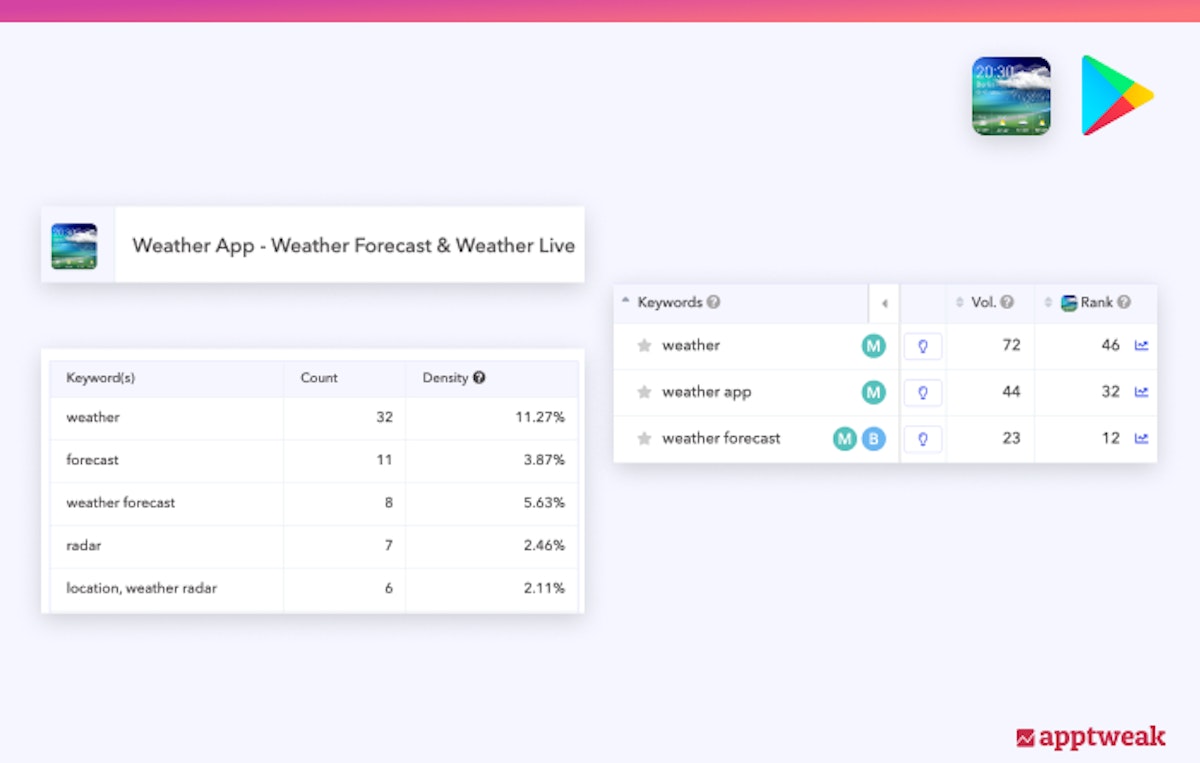
The 5 Myths of ASO
With the growing mobile market, opportunities rise and so does competition. One way of tackling the competition is to get better at App Store Optimization (ASO). Not only do you have to know what to “do right,” you also need to know what not to do. We will be covering the most common myths about ASO in this blog.
Myth #1: Descriptions aren’t important for ASO
There is a rumor floating around the ASO community that descriptions are dead. Many app owners and developers choose to ignore the description, thinking their end users will not spend their time reading the long description before downloading the app. While it is true that the impact of the long description on conversion rate has diminished over time, the long description serves a great purpose when it comes to keyword optimization in the Google Play Store. Google does take into account keywords used in the long description to decide when to show your app in the search results. In fact, at AppTweak we’ve seen greater impact on keyword rankings for keywords targeted in the long description over the short description. Therefore, it is very important to carefully optimize your long description and include 3–5 of your most important keywords. Make sure to repeat these keywords a few times (without falling into the practice of keyword stuffing) to maximize your app’s visibility.

Elevate, for example, has a greater density for “cognitive” than “memory” in their long description. As a result, the app ranks better on “cognitive games” than “memory games.”
Myth #2: Changing your title often will help you rank for more keywords
The app title is the most important field when it comes to App Store Optimization. There’s the myth that by updating the title frequently, your app will rank on more keywords. It is important to address this claim with caution. Regularly updating keywords or even changing the name of the app will not give you any advantage. On the contrary, it may harm your app visibility. Google takes into account the conversion rate on keywords into their ranking algorithm. So if Google notices that your app converts well on a certain keyword, they will rank your app higher. It does take time to build this authority, so changing your title and removing a well-performing keyword can harm your app’s visibility.
Myth #3: Adding as many keywords as possible will increase your visibility
Unlike the App Store, which utilizes the keyword field to index keywords, Google Play is more similar to traditional ASO and looks at keywords included in all metadata fields, including the long description. While this presents an opportunity to target more keywords, it also raises the questions about a common myth of whether adding as many keywords as possible will increase your app’s visibility. Well, the answer is no. Doing this will lead to keyword stuffing. Keyword stuffing is the practice of including a long list of “keywords” in an attempt to manipulate an app’s ranking in search results. Keyword stuffing is frowned upon by Google and can harm your app in the long term. It is important to work keywords into your description naturally.

Weather App, by Weather Fantasy, repeats the keyword “weather” 3 times in the title, 3 times in the subtitle, and 32 times in the long description. They even added the keyword to the developer name. Nevertheless, the app does not rank in the top 20 for the keyword “weather.” On the contrary, keyword-stuffed metadata like this signals to users that this is not a very high-quality app.
Myth #4: A great app does not need ASO
A lot of developers forget that having a great app and being in the respective app stores is not enough to ensure a steady stream of organic downloads. Creating your app is a journey on its own, but having your app discovered is a different ballgame. AppTweak research has shown that, on average, ⅓ of app store searches are searches for generic keywords. This means that if you are not optimizing your app’s visibility in the stores, you potentially miss out on ⅓ of potential downloads. This number is an average and can be much higher for games. The app stores are becoming a crowded place, and gaining visibility has become a challenge. To grow more, you need more downloads and to grow organically within the app stores, you need to leverage ASO.
Myth #5: You do not need an ASO tool
For many developers and app-based companies, apps, unlike websites, seem like comparatively small-scale engagements not worthy of ASO tools. After all, what’s so difficult about changing a couple of keywords, picking a unique name, and taking amazing screenshots of your app? Applying the principles of ASO sounds easy, but is very different when you’re trying to implement it. Competition is crowded and the room for optimization is limited. Therefore, it is important to select keywords with a high volume and low difficulty score to increase your chances to rank in the top 10. To gain an edge on your competition, you should also understand which keywords they are ranking for and find gaps where their visibility is low. ASO tools like AppTweak can help make this research easier. Nothing screams power more than having all the information at the tip of your fingers. It enables you to make better data-driven decisions to boost your downloads tenfold.
.png?auto=format,compress&q=75&w=1200)
Screenshot of AppTweak’s Keyword Tool showing metrics such as Keyword Volume, Chance Score, Keyword Rank, and Installs (the estimated organic installs a keyword drives to an app).
Debunking these smalls myths and implementing them into your ASO routine will definitely help you achieve better results. Yes, there are many more myths out there, but with more time and research, you will slowly realize that, in practice, none of them are true.



 Micah Motta
Micah Motta

 Chloé Morant
Chloé Morant

 Georgia Shepherd
Georgia Shepherd